Immediate Benefits of Quality Home Furnishings
Quality home furnishings directly enhance everyday comfort by providing furniture suited to daily activities. Well-chosen pieces create cozy environments that encourage relaxation, whether in the living room, bedroom, or workspace. For example, a supportive sofa can alleviate physical fatigue, while a well-organized workspace chair boosts focus and reduces strain.
Beyond physical comfort, these furnishings improve lifestyle quality by tailoring functionality to specific rooms. A bedroom fitted with comfortable bedding and storage solutions promotes restful sleep and order, freeing mental space from clutter-related stress. In living rooms, multi-use furniture like modular seating adapts to different needs, making socializing more enjoyable.
Also to see : What are the top UK home design tips for small kitchens?
Importantly, quality home furnishings also positively influence mental well-being. Environments that feel comfortable and thoughtfully arranged reduce stress and create a sense of calm. This peacefulness supports emotional health by providing safe spaces to unwind after demanding days.
By focusing on comfort, function, and atmosphere, quality home furnishings don’t just fill rooms—they actively uplift the people living within them. This blend of physical and psychological benefits makes investing in the right furniture a foundational step toward an improved lifestyle.
Topic to read : How can you make your UK home energy-efficient?
The Role of Furnishings in Personal Health and Ergonomics
Ergonomic furniture plays a crucial part in supporting health and wellness by promoting good posture and reducing strain. Properly designed chairs, desks, and mattresses provide necessary back support, which helps prevent chronic pain and muscular fatigue. For example, an ergonomic office chair with adjustable height and lumbar support aligns the spine correctly, lessening the risk of tension and injury during long work hours.
The impact of seating, mattresses, and workstations extends beyond immediate comfort; it influences long-term well-being. Poorly chosen furniture can lead to posture problems, fatigue, and even decreased productivity. In contrast, ergonomically designed furnishings support active, healthy living by encouraging movement, proper circulation, and muscle engagement throughout the day.
Furniture design that integrates ergonomic principles creates living and workspaces that actively contribute to physical health. Features like adjustable desks promoting standing work, memory foam mattresses contouring to body shape, and chairs with supportive cushions collectively enhance daily comfort and wellness. This practical approach to home furnishings benefits users by reducing discomfort and fostering a healthier lifestyle.
Mood and Emotional Wellness Inspired by Interior Décor
Colors, textures, and home décor choices significantly shape emotional wellness by influencing mood and creating atmospheres that foster positivity. Warm hues like soft yellows or calming blues can uplift spirits and promote relaxation. Similarly, tactile elements—such as plush cushions or natural wood—engage the senses, enhancing feelings of comfort and safety.
Personalised décor plays a key role in mood enhancement. When rooms reflect individual tastes and meaningful objects, they strengthen a sense of belonging and happiness. This emotional connection makes living spaces feel uniquely supportive, reducing feelings of isolation and stress.
Moreover, an organised, clutter-free environment contributes substantially to emotional balance. Clutter increases anxiety, while orderly spaces foster calm and control. Integrating smart storage within décor solutions helps maintain this clarity. By thoughtfully selecting and arranging decorative elements, homeowners gain a powerful tool to nurture mental well-being alongside physical comfort.
In essence, home décor intertwines with mood and emotional wellness by creating environments that are not just visually appealing but psychologically nurturing, therefore enriching the overall quality of life.
Practical Tips for Choosing Home Furnishings to Improve Life Quality
Selecting the right home furnishings requires balancing comfort, functionality, durability, and style. Prioritize comfort first, ensuring sofas, chairs, and beds support your body well and suit daily activities. Functionality means choosing pieces tailored to the room’s purpose—like a desk with storage for your workspace or modular seating for flexible living areas. Durable materials and construction extend the lifespan of furniture, making your investment worthwhile.
Incorporating multipurpose and space-saving pieces helps maximize smaller homes. For example, ottomans with hidden storage or fold-out beds add convenience without clutter. This approach improves living efficiency and supports neat, organised spaces.
Planning purchases according to lifestyle needs is essential. Assess how you use each room: Do you entertain frequently? Need extra storage? Require ergonomic support? Understanding these factors leads to smarter choices that boost home improvement and overall quality of life. Also, consider maintenance—the easier furniture is to clean and care for, the longer it stays attractive and functional.
Incorporating these practical home furnishing tips ensures your space feels welcoming, supports your daily routine, and grows with your needs.
Real-Life Scenarios: Transformative Effects of Home Furnishings
Quality home furnishings benefits are vividly illustrated through real-life examples showing notable home transformation and enhanced quality of life. For instance, individuals who adopt supportive mattresses and ergonomic chairs report significant improvements in sleep quality and reduced back pain, directly boosting health and productivity at home. These positive changes highlight how the right furnishings impact both physical comfort and daily performance.
How does quality bedding improve sleep? By providing consistent support and pressure relief, it promotes deeper, uninterrupted rest vital for physical recovery and mental clarity. Similarly, a workspace furnished with ergonomic furniture encourages better posture and focus, reducing fatigue during long work hours.
Before-and-after scenarios often reveal dramatic shifts: cluttered, uncomfortable rooms become organized, inviting spaces that foster relaxation and efficiency. Interior designers emphasize that thoughtful furniture selection transforms not just aesthetics but also occupants’ well-being.
Health professionals affirm that environments designed with ergonomics and comfort in mind contribute to reduced stress and enhanced vitality. These real-life stories reinforce how intentional choices in furnishings lead to tangible, everyday benefits that improve lifestyle and emotional wellness.




